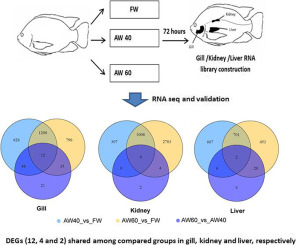当前位置:
X-MOL 学术
›
Comp. Biochem. Physiol. D Genom. Proteom.
›
论文详情
Our official English website, www.x-mol.net, welcomes your feedback! (Note: you will need to create a separate account there.)
Transcriptome changes for Nile tilapia (Oreochromis niloticus) in response to alkalinity stress.
Comparative Biochemistry and Physiology D: Genomics & Proteomics ( IF 3 ) Pub Date : 2020-01-02 , DOI: 10.1016/j.cbd.2019.100651 Yan Zhao 1 , Chengshuo Zhang 1 , Haotian Zhou 1 , Lingyuan Song 1 , Jun Wang 1 , Jinling Zhao 1
Comparative Biochemistry and Physiology D: Genomics & Proteomics ( IF 3 ) Pub Date : 2020-01-02 , DOI: 10.1016/j.cbd.2019.100651 Yan Zhao 1 , Chengshuo Zhang 1 , Haotian Zhou 1 , Lingyuan Song 1 , Jun Wang 1 , Jinling Zhao 1
Affiliation

|
Nile tilapia is an important economic fish in the world because of its fast growth, high meat yield and strong adaptability. It is more adaptable to high alkalinity than common freshwater fish and provides valuable material for developing alkaline-tolerant strains and understanding the adaptation mechanism of fish to extreme environmental stress. In this study, we employed high throughput RNA sequencing to reveal the tissues (gill, kidney and liver) transcriptome differences of O. niloticus at different carbonate alkalinities (FW, AW40 and AW60). A total of 1,369,381,790 raw reads were obtained, including 496,441,232 reads in FW group, 437,907,696 reads in AW40 and 435,032,862 reads in AW60. In addition, 484,555,626 reads in gill, 451,618,224 reads in kidney and 433,207,940 reads in liver. A large number of stress-regulated changes were detected comprehensively. We focused on 3 significantly change pathways (steroid biosynthesis, drug metabolism and protein digestion/absorption) and 17 DEGs (HMG-CoA reductase, UDP-glucuronosyltransferase, and carbonic anhydrase etc.) which were shared among compared groups (AW40 vs FW, AW60 vs FW, AW40 vs 60 AW60) in gill, kidney and liver, respectively. These pathways/genes are sensitive to alkalinity stress and crucial to the alkalinity adaptation of tilapia. Overall, we found a large number of candidate genes, which encode important regulators of stress tolerance and ultimately contribute to future alkaline-tolerant fish breeding. Among these genes, lipid metabolism (involving signal transduction), detoxification and immune related genes are more prominent to the response and adaptability of fish to alkalinity stress.
中文翻译:

尼罗罗非鱼(Oreochromis niloticus)的转录组变化响应碱度胁迫。
尼罗罗非鱼因其快速生长,高肉产量和强适应性而成为世界上重要的经济鱼类。它比普通的淡水鱼类更适合于高碱度,并为开发耐碱菌株和了解鱼类对极端环境胁迫的适应机制提供了有价值的材料。在这项研究中,我们采用高通量RNA测序揭示了在不同碳酸盐碱度(FW,AW40和AW60)下尼罗罗非鱼的组织(g,肾和肝)转录组差异。总共获得了1,369,381,790个原始读取,包括FW组中的496,441,232个读取,AW40中的437,907,696个读取和AW60中的435,032,862个读取。此外,g中的读数为484,555,626,肾脏中的读数为451,618,224,肝脏中的读数为433,207,940。全面检测到大量的压力调节变化。我们重点研究了3种显着变化的途径(类固醇生物合成,药物代谢和蛋白质消化/吸收)和17种DEG(HMG-CoA还原酶,UDP-葡糖醛酸糖基转移酶和碳酸酐酶等),在比较组之间共享(AW40与FW,AW60 vs FW,AW40 vs 60 AW60)。这些途径/基因对碱度胁迫敏感,并且对罗非鱼的碱度适应至关重要。总体而言,我们发现了大量候选基因,它们编码胁迫耐受性的重要调控因子,并最终为未来的耐碱鱼类育种做出了贡献。在这些基因中,脂质代谢(涉及信号转导)
更新日期:2020-01-02
中文翻译:

尼罗罗非鱼(Oreochromis niloticus)的转录组变化响应碱度胁迫。
尼罗罗非鱼因其快速生长,高肉产量和强适应性而成为世界上重要的经济鱼类。它比普通的淡水鱼类更适合于高碱度,并为开发耐碱菌株和了解鱼类对极端环境胁迫的适应机制提供了有价值的材料。在这项研究中,我们采用高通量RNA测序揭示了在不同碳酸盐碱度(FW,AW40和AW60)下尼罗罗非鱼的组织(g,肾和肝)转录组差异。总共获得了1,369,381,790个原始读取,包括FW组中的496,441,232个读取,AW40中的437,907,696个读取和AW60中的435,032,862个读取。此外,g中的读数为484,555,626,肾脏中的读数为451,618,224,肝脏中的读数为433,207,940。全面检测到大量的压力调节变化。我们重点研究了3种显着变化的途径(类固醇生物合成,药物代谢和蛋白质消化/吸收)和17种DEG(HMG-CoA还原酶,UDP-葡糖醛酸糖基转移酶和碳酸酐酶等),在比较组之间共享(AW40与FW,AW60 vs FW,AW40 vs 60 AW60)。这些途径/基因对碱度胁迫敏感,并且对罗非鱼的碱度适应至关重要。总体而言,我们发现了大量候选基因,它们编码胁迫耐受性的重要调控因子,并最终为未来的耐碱鱼类育种做出了贡献。在这些基因中,脂质代谢(涉及信号转导)


























 京公网安备 11010802027423号
京公网安备 11010802027423号